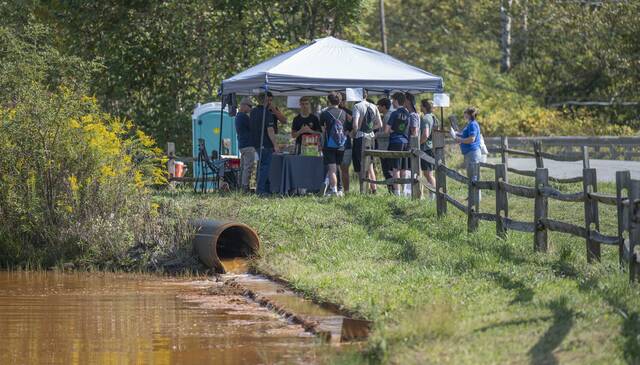Westmoreland students get hands-on environmental lesson at Lowber's mine treatment center
Greater Latrobe High School senior Anderson Schafer peered into the viewing panels of a small colorimeter Friday.
The device measures the iron content in a test tube of clear water, first collected from an abandoned mine and then cleaned as it passed through seven settling ponds at a treatment system at Lowber.
Schaefer and his fellow Greater Latrobe students were among a contingent of about 150 students from five schools in the region that learned Friday about the Sewickley Creek Watershed Association’s treatment system. The system removes iron oxide from the mine water through a passive wetland system before channeling it into nearby Sewickley Creek.
The watershed association’s annual Lowber Field Day at the treatment site is an important way of showing the students how to be good stewards of the environment, said Vanessa Whipkey, executive director of the watershed association.
The iron-laden water that flows out of the Marchand coal mine that closed in 1938 had long been a source of pollution to the orange-colored Sewickley Creek before the treatment system was created more than 20 years ago. The iron particles in the mine water are oxygenated as they move through the ponds and settle to the bottom, where the oranges sludge is removed.
“This shows how it impacts the life of the stream and how it impacts the health of the people,” Whipkey said. “It gets the kids involved so they can see that they can make a difference in their local environment and they community,” Whipkey said.
“It exposes us to things that we don’t usually think about,” said Ryanne Lehman, a Greater Latrobe senior.
Patrick Roberts, a science teacher at Greater Latrobe High School, said he oversees an environmental science capstone project where the students engage in outdoor activities such as stocking trout and testing the water at a similar system at Lawson Heights in Latrobe. Roberts said one student mentioned that in their science class, they are able to apply classroom knowledge out in the field.
It is really valuable for the students to see the mitigation system that removes mine water pollution, said Norwin High School biology teacher Joyce Muchoney, who directs the school’s Envirothon team. This generation of students is further removed from region’s heritage of coal mining, Muchoney said.
North Huntingdon has several villages with a history of coal mining, Muchoney said. The remnants of that industry has also contributed to the pollution of streams such as Brush Creek and its Tinker’s Run tributary in Irwin and North Huntingdon.
Laurel Rummel of Mt. Pleasant Area said she was surprised to learn that the orange-colored iron oxide sludge that is dug up from the bottom of the ponds can be used in making crayons.
A growing problem at the Lowber treatment system site is the increasing pile of orange-colored sludge, where the tons of particles dredged from the ponds have become harder to marke. A Virginia plant is no longer taking the sludge, said Bob Hedin, owner of Hedin Environmental of Pittsburgh.
Joe Napsha is a TribLive reporter covering Irwin, North Huntingdon and the Norwin School District. He also writes about business issues. He grew up on Neville Island and has worked at the Trib since the early 1980s. He can be reached at jnapsha@triblive.com.
Remove the ads from your TribLIVE reading experience but still support the journalists who create the content with TribLIVE Ad-Free.




